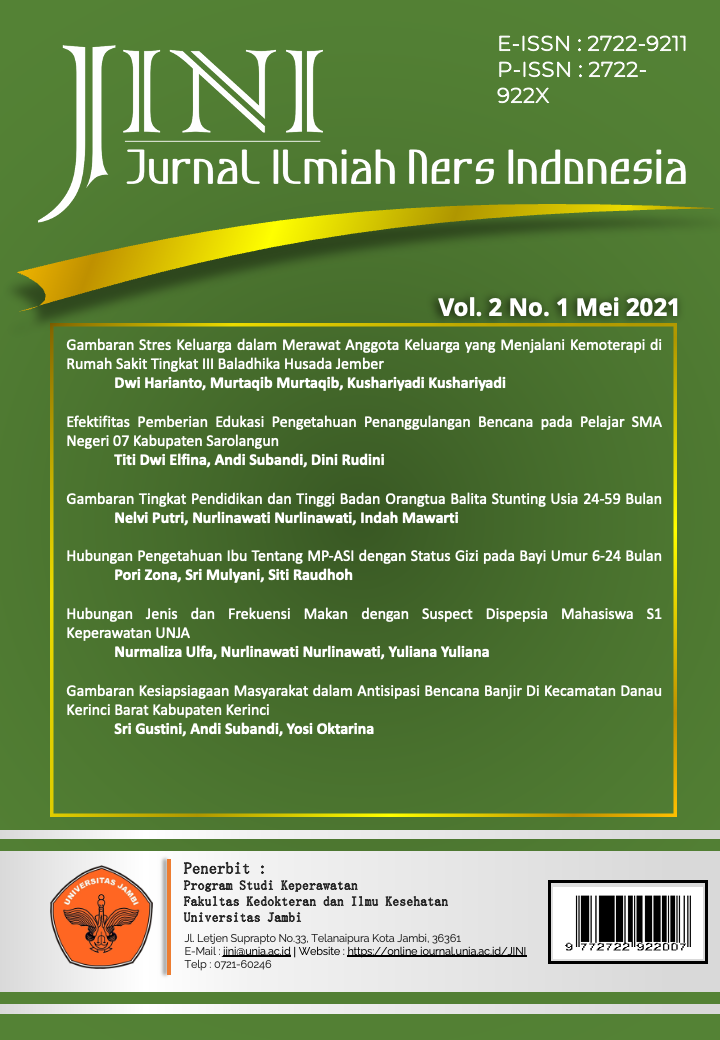Hubungan Jenis dan Frekuensi Makan dengan Suspect Dispepsia Mahasiswa S1 Keperawatan UNJA
DOI:
https://doi.org/10.22437/jini.v2i1.13529Keywords:
Type, Eating Frequency, Suspect DyspepsiaAbstract
Dyspepsia is the biggest disease in Jambi Province which ranks 9th. The influence factors occurrence of dyspepsia are the type and frequency of eating. Irregular eating habits and consuming spicy, acidic, fatty foods, coffee and soft drinks can cause dyspepsia. The purpose of the study was to know the relationship between type and eating frequency with number of suspect dyspepsia at Sarjana Degree nursing Students of Jambi University. This research is a quantitative correlational research with a cross sectional approach. Sampling using a total sampling technique of 106 samples. The instrument used was a questionnaire on the type and frequency of eating and a Suspect Dyspepsia questionnaire via google form. Data analysis using Chi Square. The results of this study showed that 41 respondents (38.7%) was suspected dyspepsia, 65 respondents (61.3%) was negative dyspepsia. the type of eating less well 64 respondents (60.4%), good was 42 respondents (39.6%). Meanwhile, the frequency of eating irregularly was 59 respondents (55.7%), while eating regularly was 47 respondents (44.3%). The results of the study on the type and frequency of eating obtained p-values of 0,000 and 0,023 <0,05, so there is a significant relationship between the type and frequency of eating with number of suspect dyspepsia at Sarjana Degree nursing Students of Jambi University.
Downloads
References
Dalam jilid 1. Edisi kelima. Jakarta : Balai Penerbit FKUI
Duboc, H., Latrache, S., Nebunu, N., & Coffin, B. 2020. The Role of Diet in Functional Dyspepsia Management. Frontiers in Psychiatry, 11(February), 1–6. https://doi.org/10.3389/fpsyt.2020.00023
Dwigint, S. 2015. The Relation of Diet Pattern to Dyspepsia Syndrom in College Students. J MAJORITY, 4(1):73-80
Ford, A. C., Marwaha, A., Sood, R., & Moayyedi, P. 2015. Global prevalence of, and risk factors for, uninvestigated dyspepsia: A meta-analysis. Gut, 64(7), 1049–1057. https://doi.org/10.1136/gutjnl-2014-307843
Indah Putri Bestari. 2020. Hubungan Pola Makan Terhadap Kejadian Dispepsia di RSUD Meuraxa Kota Banda Aceh. Jurnal Riset dan Inovasi Pendidikan, 2(1), 66-73
Ji Hao Xu. 2017. Certain Dietary Habits Contribute to the Functional Dyspepsia in South China Rular Area. Medical Science, doi: 10.12659/msm.902705, 3942-3951
Khodarahm, M., & Azadbakht, L. 2016. Dietary fat intake and functional dyspepsia. Advanced Biomedical Research, 5(1), 76. https://doi.org/10.4103/2277-9175.180988
Khomsan, A., 2004. Pangan dan Gizi untuk Kesehatan. Jakarta : PT Raja Grafindo
Piotrowicz, G., Stepien, B., & Rydzewska, G. 2013. Socio-demographic characteristics of patients with diagnosed functional dyspepsia. Przeglad Gastroenterologiczny, 8(6), 354–365. https://doi.org/10.5114/pg.2013.39918
Putri, I. S., & Widyatuti. 2019. Stres dan Gejala Dispepsia Fungsional pada Remaja. Jurnal Keperawatan Jiwa, 7(2): 203-214. https://doi.org/10.26714/jkj.7.2.2019.205-216
Putri, R. N., Ernalia, Y., & Bebasari, E. 2015. Gambaran Sindroma Dispepsia Fungsional Pada Mahasiswa Fakultas Kedokteran Universitas Riau Angkatan 2014. JOM FK Volume 2 No. 2
Sumarni. 2019. Hubungan Pola Makan dengan Kejadian Dispepsia. Jurnal Keperawatan dan Fisioterapi. 2(1). 61-66. https://doi.org/10.35451/jkf.v2i1.282
Wan Kamarul Zaman, W., Loh, S., & Mohd Esa, N. 2019. Coffee and gastrointestinal health: a review. Malaysian Journal of Medicine and Health Sciences, 15(SP1), 96–103.
Xu, J. H., Lai, Y., Zhuang, L. P., Huang, C. Z., Li, C. Q., Chen, Q. K., & Yu, T. 2017. Certain dietary habits contribute to the functional dyspepsia in South China rural area. Medical Science Monitor, 23, 3942–3951. https://doi.org/10.12659/MSM.90270
Downloads
Published
How to Cite
Issue
Section
License
Copyright (c) 2021 Jurnal Ilmiah Ners Indonesia

This work is licensed under a Creative Commons Attribution-NonCommercial-ShareAlike 4.0 International License.
Jurnal Ilmiah Ners Indonesia (JINI) memberikan akses terbuka terhadap siapapun agar informasi dan temuan pada artikel tersebut bermanfaat bagi semua orang. Semua konten artikel Jurnal ini dapat diakses dan diunduh secara gratis, tanpa dipungut biaya, sesuai dengan lisensi creative commons yang digunakan.

Ciptaan disebarluaskan di bawah Lisensi Creative Commons Atribusi-BerbagiSerupa 4.0 Internasional.



